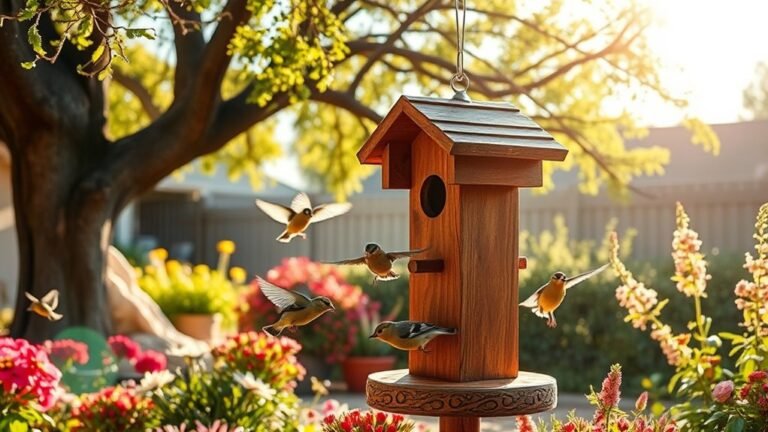Maine Local Backyard Birds
In Maine, watching backyard birds is enjoyable and rewarding. You can see many species that bring life to your yard. The American Robin marks the start of spring with its bright appearance. Colorful finches add beauty to the scene. By observing these birds, you can learn about their behaviors and habits, making a connection to nature right from your home. Think about the joy of watching these birds change with the seasons. What other types of birds might you find while you watch?
Key Takeaways
- Maine's diverse backyard birds include the American Robin, Northern Cardinal, and Eastern Bluebird, best observed throughout the seasons.
- Implement bird feeders with seeds and suet to attract a variety of species like House Finches and Downy Woodpeckers.
- Seasonal changes influence local bird populations, providing opportunities to witness migratory patterns and behaviors.
- Plant native trees and flowers to create bird-friendly habitats that support nesting and feeding for local species.
- Engaging in birdwatching enhances appreciation for nature, contributing to biodiversity awareness and conservation efforts in Maine.
American Robin: The Harbinger of Spring

The American Robin is a clear sign of spring in Maine.
These birds have bright red-orange breasts and cheerful songs. They return early in the season, marking the change in weather and encouraging people to notice nature's revival.
You may see them hopping in your yard, looking for worms and insects. This behavior is typical for their foraging.
Robins also nest in groups, creating lively neighborhoods.
Common Yellowthroat: The Masked Songster
The Common Yellowthroat is a small songbird. It has a black mask and bright yellow underparts that attract birdwatchers. This bird lives in wetland areas and prefers dense shrubs and tall grasses.
You can often hear its cheerful and raspy song in marshes. Male Common Yellowthroats sing to court females during breeding season. They announce their presence boldly and often move between low branches to catch attention.
Watching this behavior helps you learn about bird life and connect with nature. Spotting a Common Yellowthroat in your backyard can deepen your appreciation of Maine's rich natural beauty.
Eastern Bluebird: A Splash of Blue

A vibrant splash of blue brightens Maine's fields and gardens, attracting bird lovers and casual watchers.
Eastern bluebirds live in grassy areas with scattered trees, providing great spots for hunting insects. Their bright feathers and lovely songs charm everyone.
To enhance your experience with these birds, follow these three tips:
- Create a welcoming environment: Plant native flowers and keep open spaces for foraging.
- Put up bluebird houses: These houses offer safe nesting spots and help attract bluebirds to your yard.
- Watch from afar: Use binoculars to see their colors and social behaviors without disturbing them.
Enjoy the beauty of these captivating birds!
Black-capped Chickadee: The Friendly Acquaintance
The black-capped chickadee is a small bird found in Maine's backyards and woodlands.
It's friendly and curious. This bird often approaches people and checks out feeders.
Listen for its unique "chick-a-dee-dee-dee" call, which expresses contentment and alertness. Chickadees eat sunflower seeds, peanuts, and suet, making your backyard an attractive stop for them.
You can see them moving quickly between branches, showing their agility and intelligence.
These charming birds create a connection with people, inviting you to watch and enjoy their lively behavior.
Downy Woodpecker: The Tiny Tree Carpenter

The Downy Woodpecker is a small bird found in Maine's backyards. Bird watchers enjoy their unique feeding habits and beautiful appearance. You can often see them on tree trunks in open woodlands and parks.
Despite their small size, they skillfully dig into wood to find insects and larvae.
To attract Downy Woodpeckers and improve your birdwatching experience, try these tips:
- Put up suet feeders to draw in Downy Woodpeckers.
- Plant native trees like birch and oak, which they prefer.
- Watch their foraging habits; they tap on wood to uncover food beneath the surface.
Enjoy observing these tiny tree carpenters in your yard!
Northern Cardinal: The Bright Red Accent
The Northern Cardinal is a striking bird well-known for its bright red feathers. It's a common sight in Maine's backyards.
These birds thrive in various habitats, including shrubby edges, wooded areas, and residential gardens. You can often see them hopping on the ground or perched in trees, showing off their vibrant colors.
Both male and female cardinals sing sweet songs. They use their songs to mark territory and build social bonds.
The male's bright red color stands out against natural backgrounds, making it easy to spot. By knowing where cardinals like to live and how they behave, you can create a welcoming environment in your yard.
This will invite these charming birds into your life and deepen your connection with nature.
Tufted Titmouse: The Curious Little Bird
While exploring backyards in Maine, you may see the Tufted Titmouse. This small bird has a tufted crest and soft gray feathers.
It displays curious behavior as it moves through trees. Tufted Titmice thrive in both wooded and suburban areas, making them common in various places.
To enjoy these lively birds, try the following:
- Set up bird feeders with seeds to draw them in.
- Watch their playful interactions with other birds.
- Listen to their whistled calls, which add to the sounds of Maine's outdoors.
Seeing Tufted Titmice in your yard can help you appreciate Maine's natural beauty.
Mourning Dove: The Gentle Coos
In Maine's backyards, the Mourning Dove's soft cooing is a familiar sound. Their gentle calls create a peaceful atmosphere.
Mourning Doves often feed in pairs or small groups, seeking seeds on the ground. They prefer open spaces like fields and gardens, blending in with their surroundings. You can see them perched on fence posts or tree branches, showcasing their simple beauty.
Their subtle colors and calm behavior remind us to enjoy nature's peace. Each coo adds to the comfort of your backyard.
Take a moment to listen and appreciate these lovely birds.
House Finch: The Colorful Urban Dweller
As you enjoy the calm presence of Mourning Doves, look for the lively House Finch. This colorful bird adds charm to Maine's backyards.
House Finches come in shades from bright red to gentle brown, creating a lovely display. Their friendly behavior often brings energy to outdoor spaces.
To attract these delightful birds, follow these tips:
- Watch where they nest. House Finches prefer safe spots like eaves or hanging planters.
- Set up seed feeders to invite them to your yard.
- Plant native vegetation to provide shelter and food.
Let the playful spirit of House Finches brighten your backyard!
American Goldfinch: The Brilliant Yellow Visitor
The American Goldfinch is a bright yellow bird that can bring joy to backyards in Maine. You can often see them flying around during summer when their colors are most vivid.
These birds like to eat seeds from sunflowers and dandelions. They're social and make cheerful sounds, making them enjoyable to watch on warm afternoons.
Goldfinches have a specific migration pattern; they breed in the northern states and head south in late summer. However, some may stay all year if food is plentiful.
You can attract these beautiful birds to your yard by placing feeders filled with thistle seeds. This simple act can enhance your outdoor space and connect you to nature.
Purple Finch: The Rosy Feathered Friend
The Purple Finch adds a beautiful rosy color to your yard, especially in spring.
These birds nest in dense coniferous trees, which provide safety for their young. They eat seeds, berries, and nectar from flowers.
To attract Purple Finches, try these tips:
- Plant native flowers for nectar.
- Use feeders with sunflower seeds.
- Ensure there are dense shrubs nearby for nests.
With these steps, you can invite Purple Finches to your garden.
Enjoy watching these charming birds!
Red-winged Blackbird: The Vocal Marsh Nester
The Red-winged Blackbird is commonly found in wetlands and marshes. It has striking black feathers and vivid red shoulder patches.
You'll often hear its loud, trill-like calls, especially during mating season, when it defends its territory. These birds build detailed nests among reeds, showing their preference for wet areas. They mainly eat seeds, insects, and berries, adjusting their diet based on what's available.
As migratory birds, Red-winged Blackbirds travel south for the winter. Each bird has its own migration pattern. Learning about these habits helps us appreciate their role in the ecosystem and connect with the lively wildlife in Maine's local backyards.
Frequently Asked Questions
What Food Should I Provide for Backyard Birds in Maine?
To attract many backyard birds in Maine, provide sunflower seeds, mixed seeds, and suet. Use tube feeders for small birds and platform feeders for larger birds. This setup creates a friendly space for birds to visit.
How Can I Attract More Birds to My Backyard?
To attract more birds to your backyard, you can follow these steps:
- Install bird feeders. Fill them with seeds and nuts that birds enjoy.
- Plant native plants. These plants provide food and shelter, making your yard a safe space for birds.
What Time of Year Is Best for Birdwatching in Maine?
The best times for birdwatching in Maine are spring and fall. These seasons align with bird migration. In spring, many birds return from their winter homes, filling your backyard with lively activity. In fall, birds travel south, providing a great opportunity to observe different species. Enjoy the vibrant environment created by these migratory patterns and share the experience with fellow birdwatching enthusiasts.
Are There Any Endangered Bird Species in Maine?
Maine is home to several endangered bird species. Notable examples include the Peregrine Falcon and the Roseate Tern. By supporting conservation efforts, you help protect these important birds. This ensures that future generations can appreciate their beauty and vital roles in the ecosystem.
How Can I Identify Bird Songs and Calls?
To improve your bird song identification skills, practice recognizing calls. Pay attention to their pitch, rhythm, and repetition patterns. Recording and comparing these sounds can enhance your understanding and create a stronger connection to the birds around you.

Hello, I’m Amelia White, the founder of birdsfanatic.com. As a lifelong bird enthusiast and spiritual seeker, I’ve always been fascinated by the mystical connections between birds and the human experience. On this site, I share my knowledge and insights into the symbolic meanings and spiritual significance of various bird species, exploring their roles in mythology, folklore, and cultural traditions. Join me on this journey into the world of birds, where we’ll discover the hidden wisdom and guidance that these magnificent creatures have to offer.







